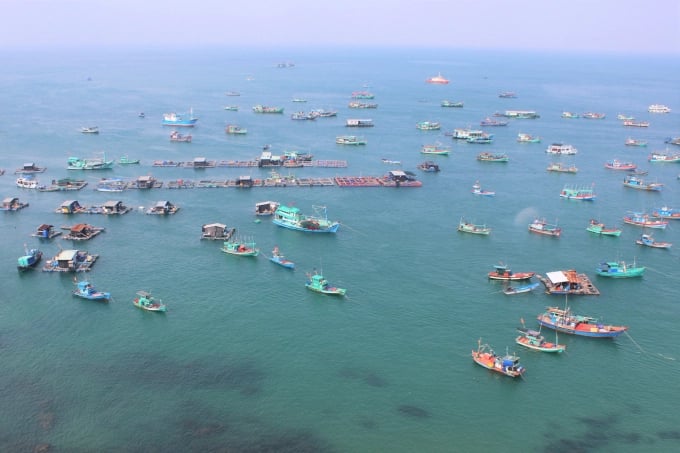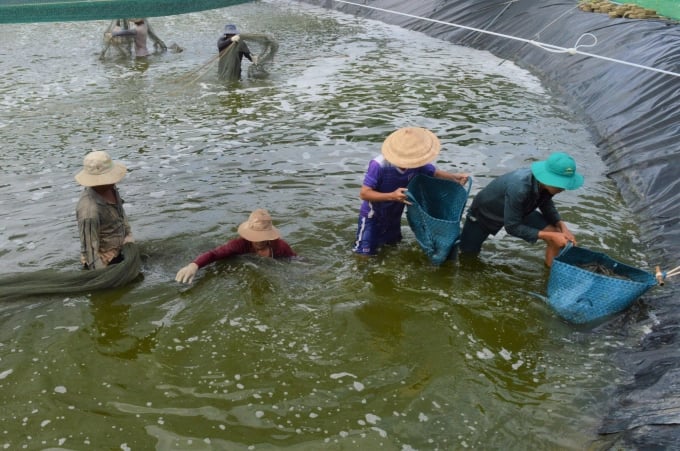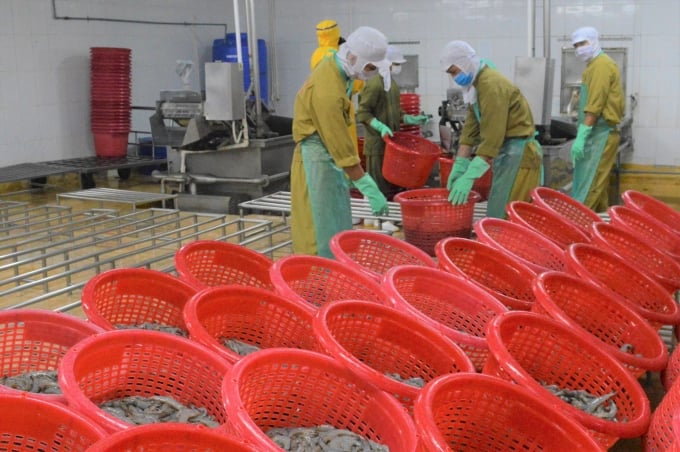June 21, 2025 | 02:49 GMT +7
June 21, 2025 | 02:49 GMT +7
Hotline: 0913.378.918
June 21, 2025 | 02:49 GMT +7
Hotline: 0913.378.918

With nearly 200 kilometers of coast and many islands, Kien Giang province has favorable conditions for the development of high-tech marine aquaculture. Photo: Trung Chanh.
The province plans to develop its marine aquaculture sustainably on an industrial scale to serve domestic consumption and exports.
It will fully tap its potential and advantages of surface water for restructuring the fisheries industry. The number of fishing boats and outputs will be gradually reduced to switch to marine farming. The scale and productivity of marine aquaculture will be increased while ensuring food safety and raising income for locals.
Foreseeing the development of the marine economy in Kien Giang Province, Mavin Group has developed a farming project which applies modern technology to produce high-quality marine fish for domestic consumption and exports. It was approved by the local authority in July 2019.

The marine aquaculture in the province is divided into two areas, including islands and coastal areas which are suitable for developing floating cage farming and brackish water aquaculture. Photo: Trung Chanh.
The project which has a total investment of US$ 30 million will cover 2,000ha of water surface. It will focus on breeding fish with high economic value namely groupers and snubnose pompano.
Once put into operation, it will produce 30,000 tonnes of marine fish a year.
The Mavin Group also signed memorandums of understanding with the provincial authority on the implementation of other projects on a seafood seed centre, processing seafood for export with a capacity of 30,000 tonnes per year.
In addition to marine aquaculture, the province has also focused on expanding brackish shrimp farming in coastal areas.

Many large-scale marine aquaculture companies have chosen Kien Giang Province to invest in shrimp farming with an area of up to thousands of hectares. Photo: Trung Chanh.
Two concentrated farming areas have been set up in U Minh Thuong district and Long Xuyen Quadrangle. Many large-scale marine aquaculture companies such as Minh Phu, Trung Son, and Thong Thuan have chosen Kien Giang to invest in shrimp farming with an area of up to thousands of hectares.
Nguyen Van Dung, director of Kien Giang Department of Agriculture and Rural Development, said the provincial authority has agreed in principle for Minh Phu High Technology Agriculture Joint Stock Company under Minh Phu Group, one of the biggest shrimp producer and exporters in Vietnam to implement a project on seawater supply for high-tech agricultural areas in the province.
Accordingly, the company will pour VND2.8 trillion (US$121 million) to carry out the project on nearly 9,840 hectares located in Ha Tien, Kien Luong, and Giang Thanh Districts. The project aims to contribute to the sustainable development of industrial shrimp farming, especially high-tech farming in Long Xuyen Quadrangle.

The completion of the seawater supply project for high-tech agricultural areas in Kien Giang will help promote shrimp farming in the province. Photo: Trung Chanh.
The project is divided into two phases. The first phase will be implemented this year and the second one will be completed by the end of June 2025.
Farmers in the province have bred more than 116,000ha of brackish-water shrimp so far this year, according to the department. Of these, the area of intensive farming and shrimp under shrimp-rice farming models accounted for the largest proportion with 25,160 ha and 89, 589ha, respectively. The total output is estimated to reach 20,500 tonnes.
It is estimated that 98,000 tonnes of shrimp will be produced this year. In the future, the output of the province is expected to increase substantially with the participation of big corporations, the department said.
The province targets an average annual growth rate of 24 percent for marine aquaculture from now to 2030.
It aims for an annual output of 113,530 tonnes for marine fish and other aquatic species by 2025 and 207,190 tonnes by 2030.
The province targets having 7,500 floating aquaculture cages on a total of 7,000ha by 2025 and 14,000 floating cages on a total of 16,000ha of the sea surface by 2030. Both traditional and high-tech breeding methods will be used.

It is estimated that 98,000 tonnes of shrimp will be produced for domestic consumption and export this year. Photo: Trung Chanh.
The province also plans to breed pearl oysters on 200ha and bivalve mollusks on a total area of 25,000ha by 2030.
To meet the targets, the province needs VND 12.7 trillion (US$ 550 million) for marine aquaculture in the 2021- 30 period. The investment money will come from central and local budgets and marine aquaculture breeders.
The province will also provide farmers breeding techniques and help near-shore fishermen switch to breeding marine fish to reduce overfishing in the area.
Translated by Do Hien
/2025/06/17/3942-2-143243_548.jpg)
(VAN) Recently, in Sweden, the Secretary of the Binh Dinh Provincial Party Committee presented the Investment Registration Certificate for the 'Polyester Fabric Recycling Complex' project to SYRE Impact-AB Company.
/2025/06/12/3721-2-202745_83.jpg)
(VAN) TH made an impression at Seoul Food 2025 with its line of natural beverages, paving the way for Vietnamese food products to enter the South Korean market.

(VAN) Soc Trang's success in rice exports stems from a strategy of developing fragrant and specialty rice cultivation areas and standardizing production toward low-emission practices.
/2025/06/11/1311-5-120811_839.jpg)
(VAN) The pig farming industry is facing the challenge of comprehensive restructuring to meet requirements for quality, safety, traceability, and market expansion both domestically and for export.

(VAN) Vietnam considers participating in ALGROALBA in order to expand agricultural production, coordinate the assessment and effective exploitation potential land.
/2025/06/05/5314-1-184727_407.jpg)
(VAN) From seemingly worthless fish scales and skin, enzymes and lactic ferments can transform by-products into peptides, opening a sustainable, effective business direction and elevating Vietnamese seafood.

(VAN) TTC AgriS and IFC signed a strategic partnership to develop a sustainable agricultural value chain, aiming to achieve the Net Zero target by 2035.